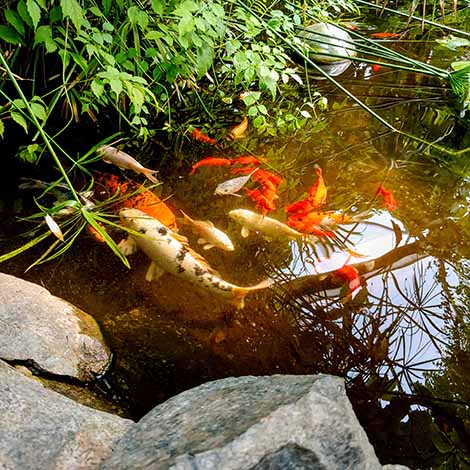From purchasing fry holding tanks to choosing the perfect fish to mate, you can go to great lengths if you're serious about koi fish breeding. For more casual homeowners, however, there are still several easy steps you can take to encourage successful koi spawning without turning it into a full-time job. In this guide, we'll cover the basics of how to breed koi fish, including when and how spawning happens and how to support it.
Create Koi Spawning Areas
The leaves, stems, and root systems of underwater plants give your pond fish safe places to spawn and lay their eggs. And when those tiny fry hatch, the plants provide protection, food, and a comfortable place to call home.
Submerged pond plants are easy to add to your water garden or fish pond. Simply fill Planting Baskets with planting media, add some oxygenators, and place the planted basket on the bottom of your pond or on a plant shelf on the side of your pond. These baskets allow the plant's roots to branch out and find nourishment while containing it and preventing fish from nibbling on its root system.
When Do Koi Spawn?
Temperature and time of year matter when it comes to koi breeding. Fish typically spawn when water temperatures are 65° to 70°F. In many ponds, this usually happens in late spring or early summer between May and June.
How Do Koi Fish Mate?
When koi prepare to spawn, the males begin chasing after the females, nudging their sides with their mouth and fins. This encourages the female koi to lay her eggs. Once eggs have been laid, the male koi will fertilize them, and the future koi will begin to grow and develop. You may also notice cloudy or foamy water accompanied by a distinct odor.
Keep Your Pond Clean
It's important that you keep the water in your pond clean and safe from potential diseases while the fry are developing. Perform regular water changes and use The Pond Guy Stress Reducer Plus when adding new water to remove chlorine and toxic heavy metals from your tap or well water. It's also helpful to add Pond Salt to the water to keep fish stress down and help prevent diseases. If you want to learn more, read our article on the benefits of using salt in koi ponds.
Keep the Fry Safe
Newly hatched fry can't swim and will need a protected area that's safe from natural predators like tadpoles, frogs, and other koi. Make sure you give them plenty of coverage with water hyacinth, water lettuce, and other floating pond plants. You might also consider using a fine mesh tent, like the Nycon Fish Spawning Incubator, to protect them and prevent them from becoming trapped in your filtration system.
As your new additions begin to grow, there will be added ammonia and nitrates in the pond. If you plan to keep these new koi, make sure you're providing adequate filtration in your pond and aren't deviating from a practical fish load based on your pond size. Having more fish in your pond than your filtration system can handle can lead to more severe algae blooms and muck accumulation. To combat this, keep adding beneficial bacteria like Nature's Defense or Muck Defense to break this waste down.
What's Next?
With a little staging and encouragement, koi fish breeding becomes a lot easier. Try implementing some of these steps this season to take your koi spawning efforts to the next level! If you have any questions along the way, our customer service team will be happy to help.
Last Updated: February 2, 2023
